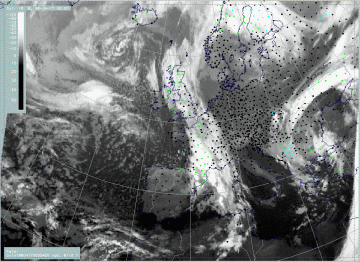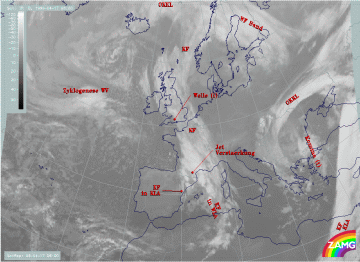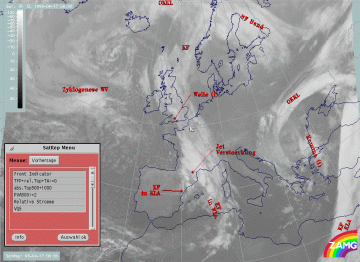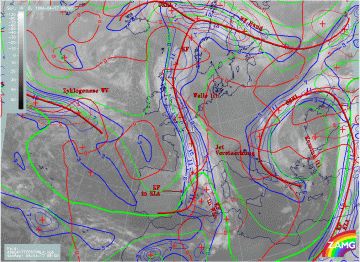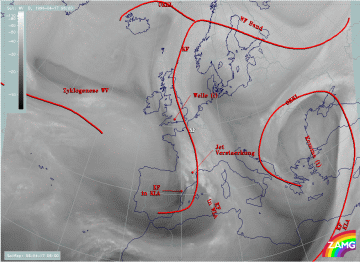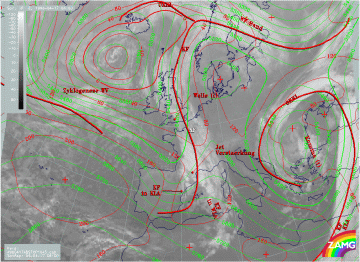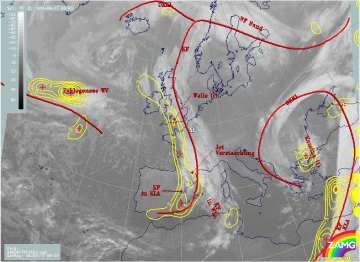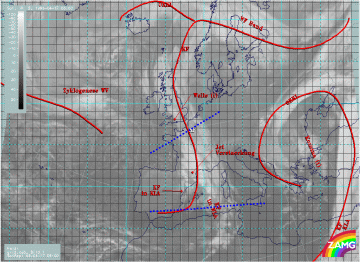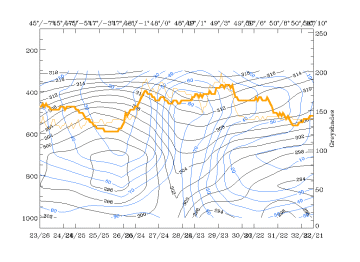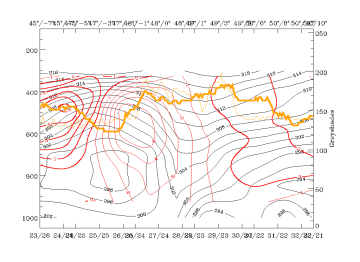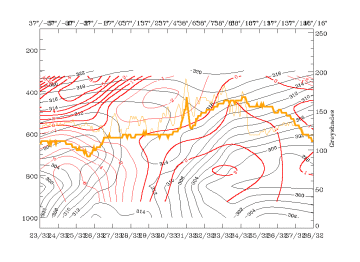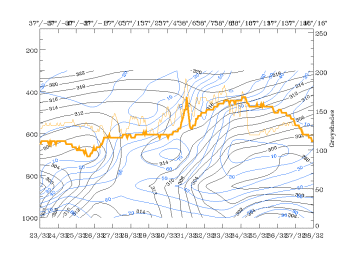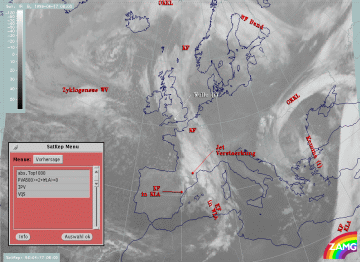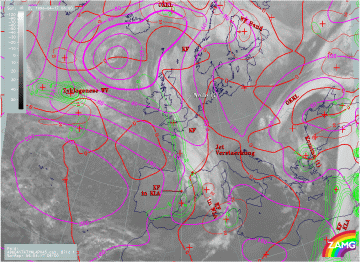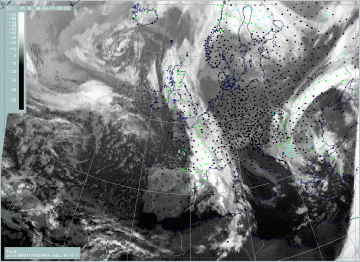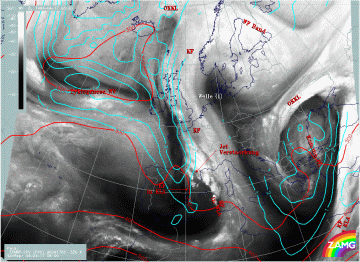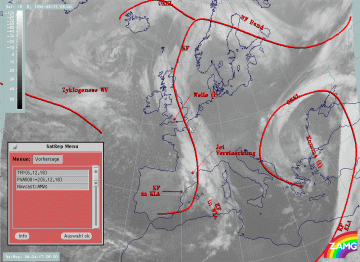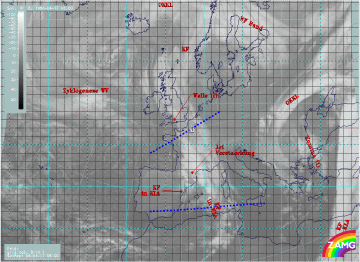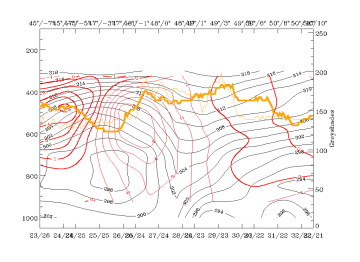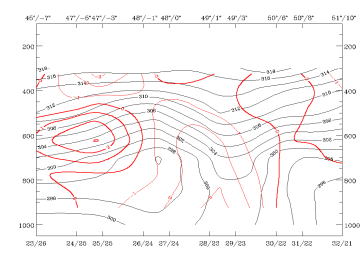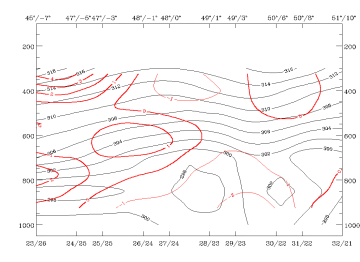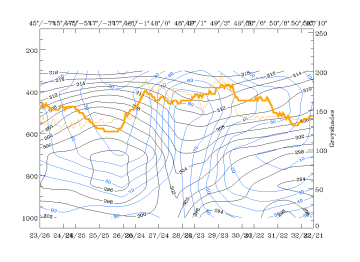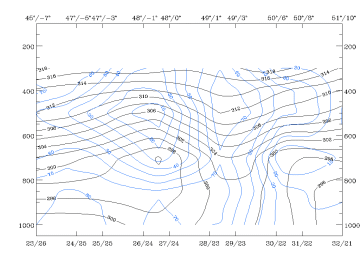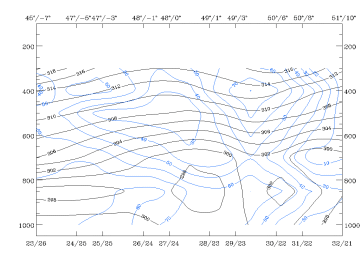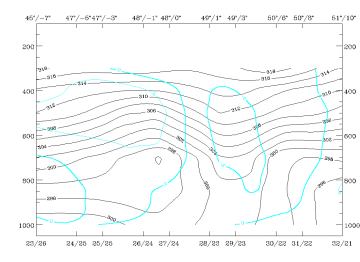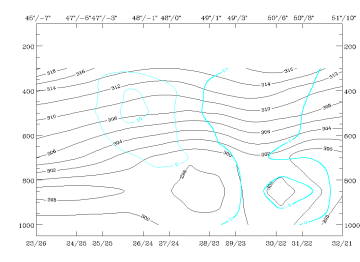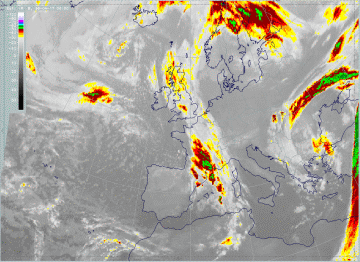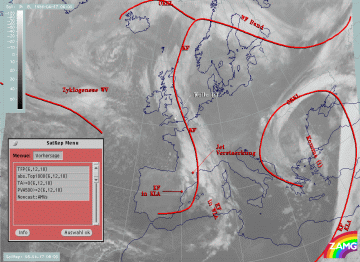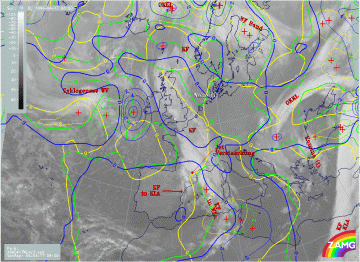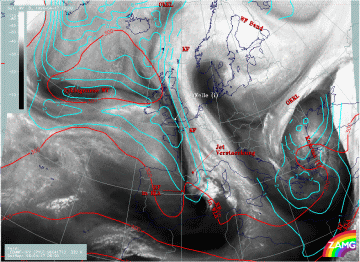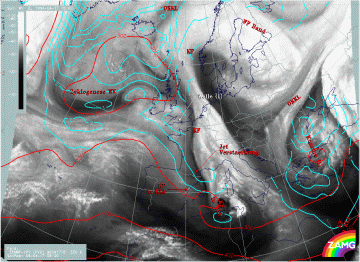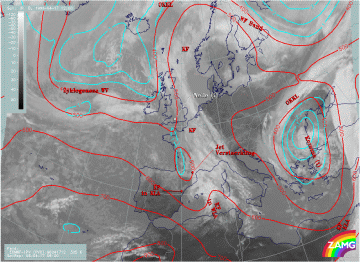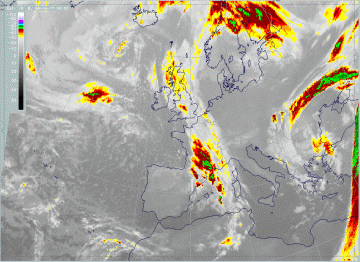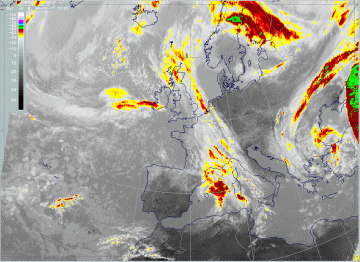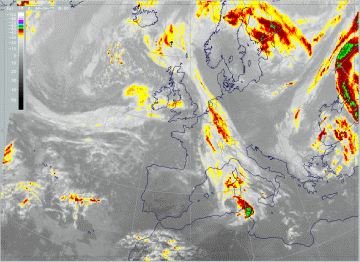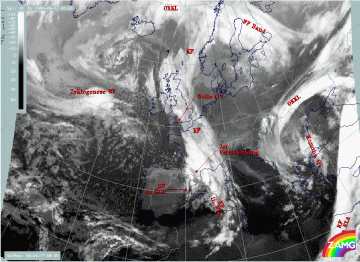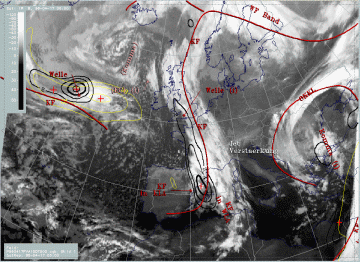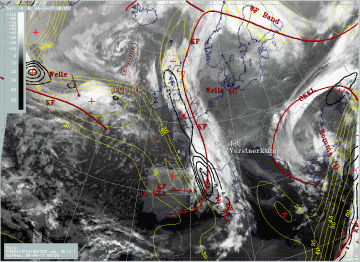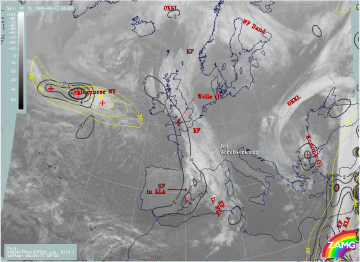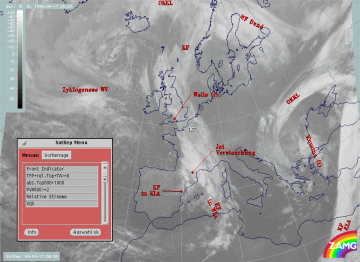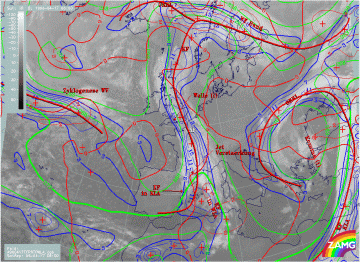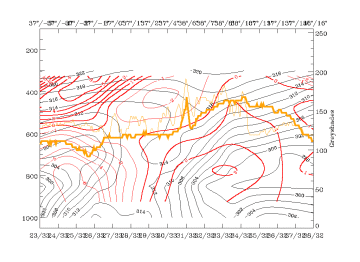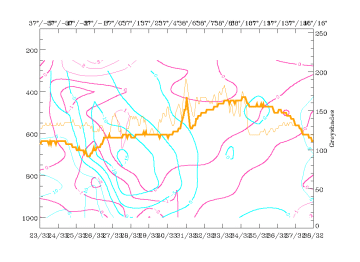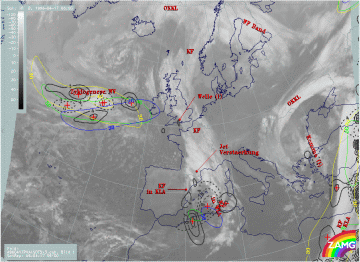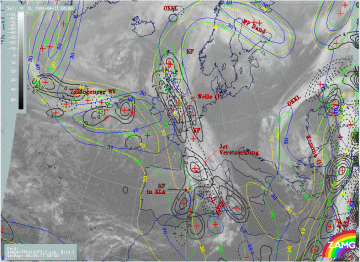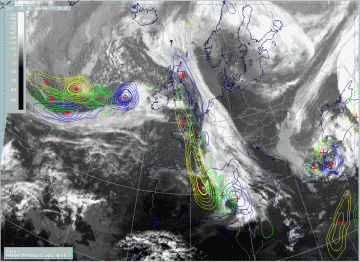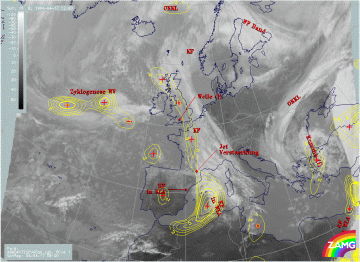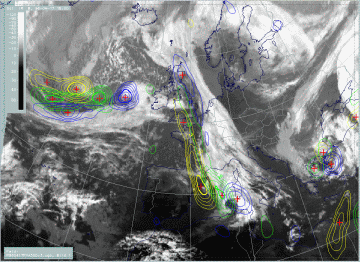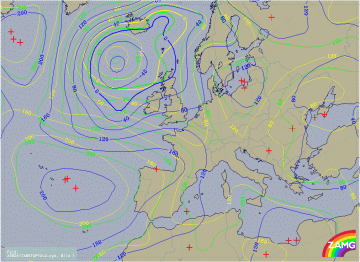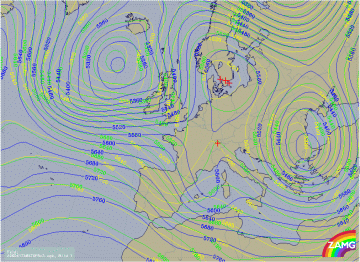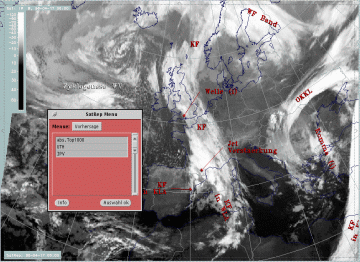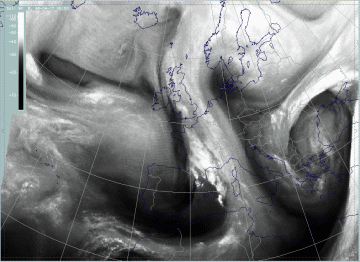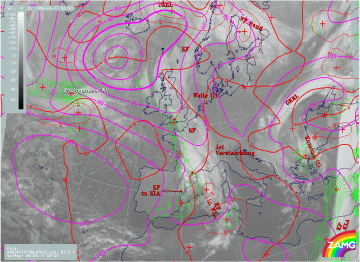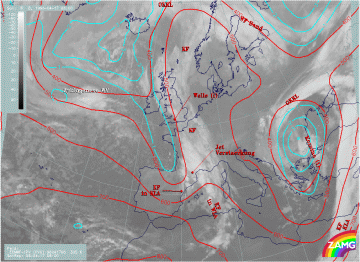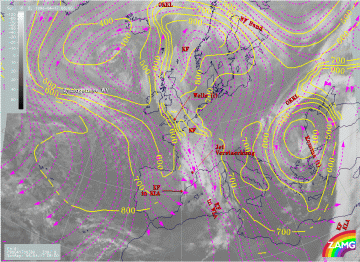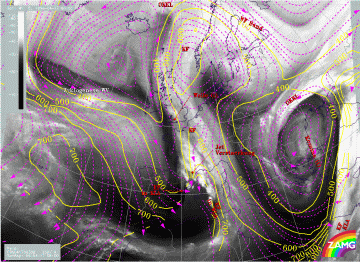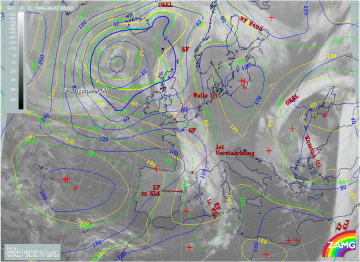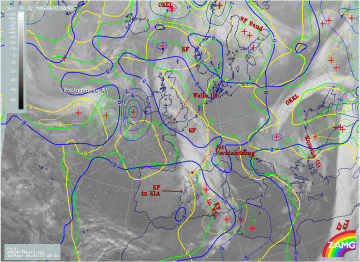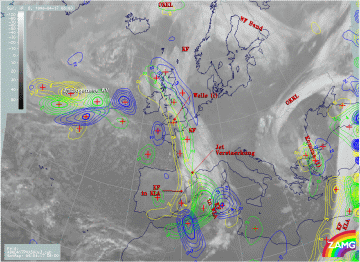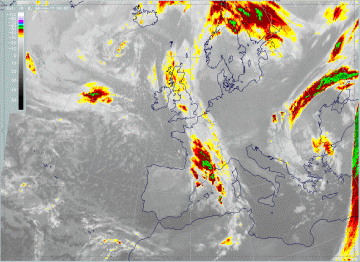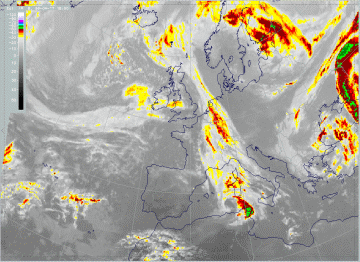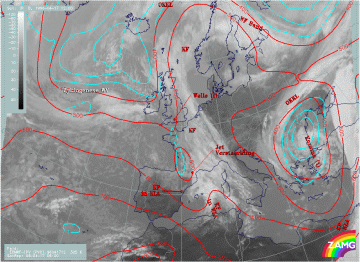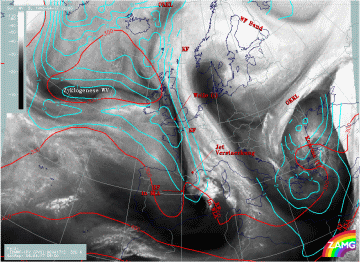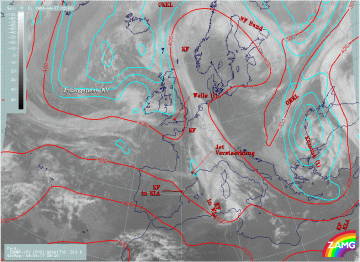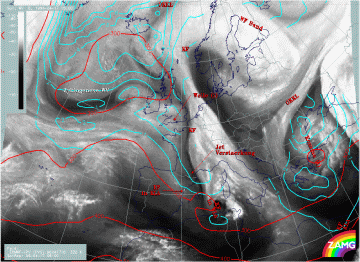Table of Contents
- I. Introduction and Conceptual Models for 17 April 1996/06.00 UTC
- II. Conceptual Models - Forecast for 17 April 1996/12.00 UTC and 18.00 UTC
- III. "Special Investigation": Cyclogenesis in the Western Mediterranean Including Detection of Numerical Model Error
- IV. "Special Investigation": Rapid Cyclogenesis Including Detection of Numerical Model Error
Introduction and short case description
|
17 April 1996/06.00 UTC - Meteosat IR image; weather events (green: rain and showers, blue: drizzle, cyan: snow, purple: freezing rain,
red: thunderstorm with precipitation, orange: hail, black: no actual precipitation or thunderstorm with precipitation)
|
|
There are two main cloud configurations which are analysed in this case study:
- A frontal cloud band extending from Africa and the western Mediterranean Sea northward across France and the British Isles to the
Norwegian coast; this cloud band has lower tops in the leading part and contains two interesting substructures:
- An intensified and broadened cloud area over France which could be indicative of the conceptual model "Wave" (compare Conceptual Models: Wave ) or the conceptual model "Front Intensification by Jet Crossing" (compare Conceptual Models: Front Intensification by Jet Crossing )
- A cloud bulge over the British Isles and Ireland indicative of the conceptual model "Wave" (compare Conceptual Models: Wave ). Cold Front cloud band and Wave are discussed in this chapter; the cloud structures over France and their development can be found as a special investigation (compare "Special Investigation": Cyclogenesis in the Western Mediterranean Including Detection of Numerical Model Error).
- A narrow cloud band over the Atlantic from approximately 47N/30W to 52N/20W; the biggest part consists of low cloud tops except for the easternmost part which shows a cloud configuration very typical of the conceptual model "Rapid Cyclogenesis". This is also discussed as a special investigation (compare "Special Investigation": Rapid Cyclogenesis Including Detection of Numerical Model Error).
Weather reports show that the leading part of the frontal cloud band is free of precipitation, but that there are broad areas of precipitation, especially in the two substructures mentioned above. Weather activity is more severe there. The second cloud system is located over the Atlantic, therefore no weather reports exist.
|
17 April 1996/06.00 UTC - Meteosat IR image; SatRep overlay: names of conceptual models
|
|
The SatRep diagnosis of this case identifies the areas already mentioned by "KF" (Cold Front) and "Welle" (Wave), but reveals, especially for the southern part which is discussed under the "special investigation", some more details. These include, for instance, "KF in KLA" which is a Cold Front under the influence of cold advection (CA), and "Jet Verstaerkung" (Jet Intensification).
17 April 1996 - Cold Front
|
17 April 1996/06.00 UTC - Meteosat IR image; SatRep overlay: names of conceptual models, SatRep menu: key parameters for Cold Front
|
|
For the diagnosis of the Cold Front a couple of key parameters with special thresholds as well as useful combinations of key parameters have been developed (for more information compare also the manual, Conceptual Models: Cold Front ).
| Front Indicator: | This is a line indicating the maximum of the thermal front parameter (TFP) 500/850 hPa (*10-1K m-1) |
|---|---|
| TFP + rel.Top + TA>=0: | This combination contains the thermal front parameter (TFP) 500/850 hPa greater than 3 units, the equivalent thickness (rel.Top) 500/850 hPa (K) and warm advection 500/1000 hPa (TA>=0) (K 12h-1); this parameter combination contains the information about the thermal situation in the area of the Cold Front |
| TFP + Scher300=0: | This is a combination of the thermal front parameter (TFP) 500/850 hPa greater then 3 units and the zero line of shear vorticity at the 300 hPa level (Scher300=0); this combination of key parameters is indicative of the relation between front and jet stream |
| abs.Top500 + abs.Top1000: | This is the combination of height contours at 1000 and 500 hPa (gpm); this combination of key parameters is indicative of the stream and pressure distribution near the surface and in the middle of the troposphere |
| PVA500>=2: | This field shows areas of positive vorticity advection (PVA) at 500 hPa greater than 2 units (*10-9sec-2); this key parameter indicates areas with increased possibility for more severe weather events because of increased vertical motion (compare also Conceptual Models: Wave and Conceptual Models: Front Intensification by Jet Crossing ) |
| Relative Stroeme: | This parameter shows relative streams on isentropic surfaces; relative streams are indicative of the different air masses involved in the process of sinking or rising areas; they can be used to explain cloud configurations requiring special explanation |
| VQS: | Gives the location of available vertical cross sections (VQS) |
|
17 April 1996/06.00 UTC - Meteosat IR image; blue: thermal front parameter (TFP) 500/850 hPa, red thick: front indicator, green:
equivalent thickness 500/850 hPa, red: temperature advection - WA 1000 hPa; SatRep overlay: names of conceptual models
|
17 April 1996/06.00 UTC - Meteosat WV image; red thick: front indicator; SatRep overlay: names of conceptual models
|
The combination of TFP (blue), thickness (green) and TA (red) shows, in an area reaching from France northwards, a quite classical situation with the front locator (thick red line) more to the rearward edge of the cloud band, except for the cloud bulge over the British Isles where it is more on the leading edge. According to the WV image, there is a broad band of high WV values extending over the IR band, especially in the eastern part. A more complicated distribution of relevant parameters can be seen in the Mediterranean with two cyclonically curved cloud bands: the eastern one reaching from south France to Tunisia, and a western, very short one which is along the east coast of Spain. There are also two branches in the TFP field, but the identification especially of the eastern cloud band as Cold or Warm Front is not evident. This area is the subject of one of the "special investigations" and will not be discussed here (compare "Special Investigation": Rapid Cyclogenesis Including Detection of Numerical Model Error).
Equivalent thickness (green) reveals that there is a trough at the rear of the cloud band which is very pronounced but does not show a broad zone of high gradients. Consequently, the change from warm air within the thickness ridge in front of the cloud band to the cold air in the thickness trough behind it is not so well developed in this kind of presentation. Although the zero line of temperature advection (TA) is very close to the frontal edge of the cloud band, there are no pronounced centres of WA and CA.
The situation in the Mediterranean differs from the one described just now with much more distinct gradients in the thickness and a well-developed area of WA. This will be discussed in the special investigation (compare "Special Investigation": Cyclogenesis in the Western Mediterranean Including Detection of Numerical Model Error).
In summary, the frontal cloud band is not accompanied by very distinct transitions of air masses in the layer under discussion (500/850 hPa); reasons for this may be that it is already an old system or that there are distinct differences in the single layers which are averaged in the whole layer. Vertical cross sections which are discussed further below can give an answer to these assumptions.
|
17 April 1996/06.00 UTC - Meteosat IR image; red: height contours 1000 hPa, green: height contours 500 hPa; SatRep overlay: names of
conceptual models
|
17 April 1996/06.00 UTC - Meteosat IR image; red thick: front indicator, yellow: positive vorticity advection (PVA) 500 hPa; SatRep
overlay: names of conceptual models
|
Height charts close to the surface level (red) and at 500 hPa (green) contain unusually sharp troughs at both levels which are shifted in such a way relative to each other that there is a westward inclination with height, a very common situation. The situation is completely different for the cloud area in the Mediterranean and will be discussed in the "special investigation" (compare "Special Investigation": Cyclogenesis in the Western Mediterranean Including Detection of Numerical Model Error).
The yellow lines in the right image represent maxima of positive vorticity advection at 500 hPa (PVA) and accompany the rear side of the frontal cloud band with the main maximum over the Mediterranean part (compare"Special Investigation": Cyclogenesis in the Western Mediterranean Including Detection of Numerical Model Error) and a second maximum immediately south of the cloud bulge. The latter is typical for an ongoing Wave development (compare Wave or Conceptual Models: Wave ).
|
17 April 1996/06.00 UTC - Meteosat IR image; red thick: front indicator, ECMWF grid superimposed; postiion of vertical cross section
indicated, SatRep overlay: names of conceptual models
|
|
There are two vertical cross sections computed: the northern one is between the two cloud systems and should be very characteristic of the type of frontal cloud band under discussion. The southern one should be characteristic of the double structure in the Mediterranean and is shown here only for comparison purposes. For a detailed discussion see the "special investigation" (compare "Special Investigation": Cyclogenesis in the Western Mediterranean Including Detection of Numerical Model Error).
|
17 April 1996/06.00 UTC - Vertical cross section; black: isentropes (ThetaE), blue: relative humidity, orange thin: IR pixel values,
orange thick: WV pixel values
|
17 April 1996/06.00 UTC - Vertical cross section; black: isentropes (ThetaE), red thin: temperature advection - CA, red thick:
temperature advection - WA, orange thin: IR pixel values, orange thick: WV pixel values
|
In contrast to the diagnosis of the frontal cloud band as a Cold Front, the lines of the equivalent potential temperature (black) show a configuration which is very similar to an Occlusion forming a trough, with zones of high gradients on both sides of the trough, minimum and high values of humidity centred around it (blue lines for relative humidity and orange lines for satellite top temperatures in the left panel). This result would confirm the conclusion made above that the system is already an old one and would reject the other possible conclusion of having different states in different layers.
However, there are a lot of reasons which contradict the diagnosis of an Occlusion cloud band:
- The left, Cold Front - like zone of high gradients of isentropes reaches deep down to the earth surface
- There is no warm advection (red in the right cross section) in the area where the isentropes are forming a trough.
But the latter is an absolutely necessary condition for the development of an Occlusion.
Consequently, the conclusion would be that there is a Cold Front in an advanced stage of development, mostly under the influence of CA, with a broad cloud band mostly in front of the Cold Front zone characterized by the isentropes. This Cold Front zone is on top and in front of an unstable air mass centred around 47N/03W which is in the cold, cloud free air behind the frontal cloud band. Because of very dry and cold air which reaches from the top of the troposphere down to approximately 800 hPa no cloudiness develops. The WV imagery shows the dry air as a pronounced black stripe in the area of Brittany.
|
17 April 1996/06.00 UTC - Vertical cross section; black: isentropes (ThetaE), red thin: temperature advection - CA, red thick:
temperature advection - WA, orange thin: IR pixel values, orange thick: WV pixel values
|
17 April 1996/06.00 UTC - Vertical cross section; black: isentropes (ThetaE), blue: relative humidity, orange thin: IR pixel values,
orange thick: WV pixel values
|
The vertical cross sections in the southern part of the cloud band have at first glance some similarities to the northern cross section just discussed. There is an unstable area on the western edge and a Warm Front - like frontal zone in the eastern half of the cross section; but there are also important differences, for instance in the distribution of dry and humid zones, which may lead to the mentioned double structure there and which are discussed in one of the "special investigation" (compare "Special Investigation": Cyclogenesis in the Western Mediterranean Including Detection of Numerical Model Error).
17 April 1996 - Wave
|
17 April 1996/06.00 UTC - Meteosat IR image; SatRep overlay: names of conceptual models, SatRep menu: key parameters for Wave
|
|
The cloud bulge at the rear side of a frontal cloud band which is characteristic of the conceptual model "Wave", indicating the possibility of secondary cyclogenesis, can be seen in this case over the British Isles. The marking of the conceptual model in the SatRep close to south England should indicate the low centre, while the cloud bulge characterizes warm air being advected within low circulation (compare Conceptual Models: Wave ).
For the diagnosis of the physical state of the conceptual model "Wave", a couple of key parameters and useful key parameter combinations are available which were chosen with respect to this model.
| ABSTOP1000 + PVA500>=2 + WLA: | This is a commonly used combination of three parameters typically indicative of a Wave:
|
|---|---|
| PV: | Represents isentropic potential vorticity (*10-6m2K sec-1kg-1) at several levels |
| VQS: | Gives the location of available vertical cross sections (VQS) |
|
17 April 1996/06.00 UTC - Meteosat IR image; magenta: height contours 1000 hPa, red: temperature advection - WA 1000 hPa, green:
positive vorticity advection (PVA) 500 hPa; SatRep overlay: names of conceptual models
|
|
Two of the three selected key parameters fulfil the conditions of the conceptual model "Wave" quite well: there is a pronounced trough in the height field of 1000 hPa (magenta) with a minimum from central England to north France, and a maximum of PVA (green) over south England and the English Channel. The third parameter, TA, which should form a WA maximum within the cloud bulge next to a CA maximum in the cloud-free air, shows only a very weak WA area in front of the cloud bulge.
So, the situation does not show perfect conditions for the key parameters usually used. Therefore, additional parameters are taken into account. These are for instance isentropic potential vorticity (compare Conceptual Models: Wave - Meteorological physical background ) which, in a well developed situation, shows stratospheric air characterized by values higher than 2 PV units. If a Rapid Cyclogenesis takes place, stratospheric air reaches deep down to about 500 - 450 hPa, while for weak, slow cyclogenesis, stratospheric air can only be followed down to about 300 hPa.
|
17 April 1996/06.00 UTC - Meteosat IR image; weather events (green: rain and showers, blue: drizzle, cyan: snow, purple: freezing rain,
red: thunderstorm with precipitation, orange: hail, black: no actual precipitation or thunderstorm with precipitation)
|
|
|
17 April 1996/06.00 UTC - Meteosat WV image; cyan: potential vorticity (PV) 320K, red: isobars; SatRep overlay: names of conceptual
models
|
17 April 1996/06.00 UTC - Meteosat IR image; cyan: potential vorticity (PV) 305K, red: isobars; SatRep overlay: names of conceptual
models
|
Two isentropic surfaces are chosen: 320K which is very high according to the vertical cross section in the upper panel, and 305K which is well situated within the frontal surface. Both images show a trough of PV isolines (cyan) on the rear side and parallel to the frontal cloud band from north-west of Scotland down to south France. On the higher isentropic surface (left image), stratospheric air with values higher than 3 units has reached height levels only around 300 hPa. But on the lower isentropic surface, PV values between 1 and 2 indicate the transition between tropospheric and stratospheric air in a height layer between 500 and 400 hPa which is rather low. This is in line with the vertical cross section (upper panel), where stratospheric air in an area around 47N/03W reaches down to about 600 hPa and is connected with low IR and WV pixel values.
From these results an integration of dry stratospheric air into the process of cyclogenesis cannot be excluded, and supports the diagnosis of the conceptual model "Wave" even if there are some contradictory conditions. A further possibility for getting more information is to look at changes in the forecast fields. This possibility is described in a separate chapter.
17 April 1996 - Forecast For Cold Front
|
17 April 1996/06.00 UTC - Meteosat IR image; red thick: front indicator, SatRep overlay: names of conceptual models, SatRep menu: key
parameters for Cold Front forecast
|
|
Concerning the forecast of the conceptual model "Cold Front", in the SatRep Menu a button "Vorhersage" (= forecast) has to be clicked and the relevant menu appears. As can be seen in the right upper corner, two kinds of forecasts and forecast times are presented:
The very short range forecast VSRF (06.00 - 18.00 UTC, 12 hours)
For the very short range forecasts, six-hourly forecasts from ECMWF are used and those parameters which are key parameters of a conceptual model are prepared as overlays on the satellite image in three different colours, representing the three points of time 06.00, 12.00 and 18.00 UTC:
- yellow: 06.00 UTC
- green: 12.00 UTC
- blue: 18.00 UTC
In the case of the conceptual model "Cold Front" the thermal front parameter (TFP) and maxima of positive vorticity advection (PVA500>=2) are considered.
Nowcasting (0-2 hours)
For this forecast time atmospheric motion vectors (AMVs) are used which extrapolate the cloud systems for the next two hours. These nowcasts are renewed half-hourly or hourly and are not discussed here.
|
17 April 1996/06.00 UTC - Meteosat IR image; yellow: thermal front parameter (TFP) 500/850 hPa 06.00 UTC, green: thermal front
parameter (TFP) 500/850 hPa 12.00 UTC, blue: thermal front parameter (TFP) 500/850 hPa 18.00 UTC; SatRep overlay: names of conceptual
models
|
|
The propagation of the thermal front parameter (TFP) in the part of the Cold Front north of the Pyrenees shows a rather moderate north-eastward movement of about 3 - 4 degrees of latitude. The shape of the TFP stays fairly constant, in particular the Wave - like bulge remains but can be found displaced to the north. Consequently the TFP maximum moves from a location in the middle of the English Channel at 06.00 UTC to the south of the Netherlands at 18.00 UTC, and the Wave bulge from south England at 06.00 UTC to a position east of Scotland at 18.00 UTC.
This rather weak change in the forecast can also be supported by the forecast from the vertical cross section.
|
17 April 1996/06.00 UTC - Meteosat IR image; red thick: front indicator, ECMWF grid superimposed; postiion of vertical cross section
indicated, SatRep overlay: names of conceptual models
|
17 April 1996/06.00 UTC - Vertical cross section; black: isentropes (ThetaE), red thin: temperature advection - CA, red thick:
temperature advection - WA, orange thin: IR pixel values, orange thick: WV pixel values
|
|
17 April 1996/12.00 UTC - Vertical cross section; black: isentropes (ThetaE), red thin: temperature advection - CA, red thick:
temperature advection - WA, orange thin: IR pixel values, orange thick: WV pixel values
|
17 April 1996/18.00 UTC - Vertical cross section; black: isentropes (ThetaE), red thin: temperature advection - CA, red thick:
temperature advection - WA, orange thin: IR pixel values, orange thick: WV pixel values
|
The isentropic surfaces characteristic of the front (black lines) shows a continuation of the formation of the trough configuration which in the typical case would be characteristic of an Occlusion band. An eastward movement of the whole configuration as well as an upward shift of the 302K isoline can be observed. The latter fact especially would support the transition of the Cold Front into an Occlusion. However, as with 06.00 UTC (compare Cold Front ) there is CA in the area under discussion; only at 18.00 UTC in high levels does some slight WA approach from the east.
|
17 April 1996/06.00 UTC - Vertical cross section; black: isentropes (ThetaE), blue: relative humidity, orange thin: IR pixel values,
orange thick: WV pixel values
|
17 April 1996/12.00 UTC - Vertical cross section; black: isentropes (ThetaE), blue: relative humidity, orange thin: IR pixel values,
orange thick: WV pixel values
|
|
17 April 1996/18.00 UTC - Vertical cross section; black: isentropes (ThetaE), blue: relative humidity, orange thin: IR pixel values,
orange thick: WV pixel values
|
|
The dry air west of and below the frontal cloud band and the western part of the frontal zone in the vertical cross section sinks, especially between 06.00 and 12.00 UTC; a centre of 20 - 10% can be followed from about 300 hPa at 06.00 UTC down to 500 hPa at 12.00 UTC. For 18.00 UTC no further distinct changes can be noticed.
So from the material shown here no major changes to the Cold Front can be expected, despite a slight eastward movement and a continuation of the physical processes within the frontal cloud band. A rapid decrease in activity cannot be expected because, although decreasing, there is still upward motion between 12.00 and 18.00 UTC, as can be seen from the cross sections below.
|
17 April 1996/06.00 UTC - Vertical cross section; black: isentropes (ThetaE), cyan thick: vertical motion (omega) - upward motion, cyan
thin: vertical motion (omega) - downward motion, orange thin: IR pixel values, orange thick: WV pixel values
|
17 April 1996/12.00 UTC - Vertical cross section; black: isentropes (ThetaE), cyan thick: vertical motion (omega) - upward motion, cyan
thin: vertical motion (omega) - downward motion, orange thin: IR pixel values, orange thick: WV pixel values
|
|
17 April 1996/18.00 UTC - Vertical cross section; black: isentropes (ThetaE), cyan thick: vertical motion (omega) - upward motion, cyan
thin: vertical motion (omega) - downward motion, orange thin: IR pixel values, orange thick: WV pixel values
|
|
The satellite images for the three points of time confirm these conclusions quite well, but there are two effects which could not have been derived from the forecast material presented here:
- The narrowing of the frontal cloud band over the North Sea which may be a consequence of the continuation of secondary cyclogenesis (this is discussed together with the Wave below);
- The widening of the cloud band over France which may be connected with the processes in the Mediterranean and is discussed under the "special investigation" (compare "Special Investigation": Cyclogenesis in the Western Mediterranean Including Detection of Numerical Model Error).
|
17 April 1996/06.00 UTC - Meteosat IR enhanced image
|
17 April 1996/12.00 UTC - Meteosat IR enhanced image
|
|
17 April 1996/18.00 UTC - Meteosat IR enhanced image
|
|
17 April 1996 - Forecast For Wave
|
17 April 1996/06.00 UTC - Meteosat IR image; SatRep overlay: names of conceptual models, SatRep menu: key parameters for Wave forecast
|
|
Concerning the forecast of the conceptual model "Wave", in the SatRep Menu a button "Vorhersage" (= forecast) has to be clicked and then the relevant menu appears. As can be seen, two kinds of forecasts and forecast times are presented:
The very short range forecast VSRF (06.00 - 18.00 UTC, 12 hours)
For the very short range forecast, six-hourly forecasts from ECMWF are used and those parameters which are key parameters of a conceptual model are prepared as overlays on the satellite image in three different colours, representing the three points of time 06.00, 12.00 and 18.00 UTC:
- yellow: 06.00 UTC
- green: 12.00 UTC
- blue: 18.00 UTC
In the case of the conceptual model "Wave", the thermal front parameter (TFP), the height contours for 1000 hPa, warm advection (TA>=0) and the maxima of positive vorticity advection (PVA500>=2) are taken into account.
Nowcasting (0-2 hours)
For this forecast time, atmospheric motion vectors (AMVs) are used which extrapolate the cloud systems for the next two hours. These nowcasts are renewed half-hourly or hourly and are not discussed here.
|
17 April 1996/06.00 UTC - Meteosat IR image; yellow: height contours 1000 hPa 06.00 UTC, green: height contours 1000 hPa 12.00 UTC,
blue: height contours 1000 hPa 18.00 UTC; SatRep overlay: names of conceptual models
|
|
|
17 April 1996/06.00 UTC - Meteosat IR image; yellow: height contours 1000 hPa 06.00 UTC, green: height contours 1000 hPa 12.00 UTC,
blue: height contours 1000 hPa 18.00 UTC; SatRep overlay: names of conceptual models
|
17 April 1996/06.00 UTC - Meteosat IR image; yellow: temperature advection - WA 1000 hPa 06.00 UTC, green: temperature advection - WA
1000 hPa 12.00 UTC, blue: temperature advection - WA 1000 hPa 18.00 UTC; SatRep overlay: names of conceptual models
|
|
17 April 1996/06.00 UTC - Meteosat IR image; yellow: positive vorticity advection (PVA) 500 hPa 06.00 UTC, green: positive vorticity
advection (PVA) 500 hPa 12.00 UTC, blue: positive vorticity advection (PVA) 500 hPa 18.00 UTC; SatRep overlay: names of conceptual
models
|
|
All three parameters show the same movement from the central English Channel northward into the North Sea. The PVA maximum remains approximately at the same strength and is centred at 18.00 UTC immediately east of Scotland. The smallest propagation shows the area of WA which is still very weak, in contrast to the possible conclusion drawn from the discussion at 06.00 UTC (compare Wave ) that it could strengthen during the process of cyclogenesis; this cannot be seen in the forecast material.
For this Wave development which does not fit fully into the classical conceptual model because of the deviating behaviour of the temperature advection field, an additional parameter has been taken into account: PV on two isentropic surfaces (compare Wave ). Forecast PV fields can help for decide about further development or decrease of the Wave.
|
17 April 1996/12.00 UTC - Meteosat WV image; cyan: potential vorticity (PV) 320K, red: isobars; SatRep overlay: names of conceptual
models
|
17 April 1996/18.00 UTC - Meteosat WV image; cyan: potential vorticity (PV) 320K, red: isobars; SatRep overlay: names of conceptual
models
|
|
17 April 1996/12.00 UTC - Meteosat WV image; cyan: potential vorticity (PV) 305K, red: isobars; SatRep overlay: names of conceptual
models
|
17 April 1996/18.00 UTC - Meteosat WV image; cyan: potential vorticity (PV) 305K, red: isobars; SatRep overlay: names of conceptual
models
|
The higher level of 320K (upper two images) describes a region approximately in or slightly above the 300 hPa level. For both points of time dry, stratospheric air represented by high PV values can be seen behind the frontal cloud band and coinciding with the black areas in the WV imagery. The lower levels of 305K (12.00 UTC) and 310K (18.00 UTC) still show an area where air mass changes from tropospheric to stratospheric values close to the Wave point and at heights of approximately 400 - 550 hPa, but they do not indicate a further sinking of dry stratospheric air.
Consequently from the PV fields no Rapid Cyclogenesis can be deduced but rather, taking all forecast parameters into account, a slow further development of the Wave. The images below confirm these ideas. The narrowing of the cloud band mentioned before fits well together with the dry air, although an exact forecast of cloud boundaries from this material seems to be rather difficult.
|
17 April 1996/06.00 UTC - Meteosat IR enhanced image
|
17 April 1996/12.00 UTC - Meteosat IR enhanced image
|
|
17 April 1996/18.00 UTC - Meteosat IR enhanced image
|
|
17 April 1996 - Cyclogenesis In The Western Mediterranean: Diagnosis For 17 April 06.00 UTC
|
17 April 1996/06.00 UTC - Meteosat IR image; SatRep overlay: names of conceptual models
|
|
The Cold Front cloud band has already been discussed in part 1 of this case study (compare Cold Front ), but the part in that section concerning the cloud band situated over south France and the western Mediterranean shows a more complicated structure and has been shifted to the "special investigation" under discussion.
The diagnosis in the SatRep indicates three different conceptual models:
- A "Front Intensification by Jet Crossing", called "Jet Intensification" (compare Conceptual Models: Front Intensification by Jet Crossing ) in the area of enhanced cloudiness over south France and the Pyrenees
- A "Cold Front in Cold Advection" (compare Conceptual Models: Cold Front in Cold Advection ) for the short front-like branch south of the Pyrenees along the Spanish east coast
- A "Cold Front in Warm Advection" (compare manual, Conceptual Models: Cold Front in Warm Advection ) for the eastern branch in the western Mediterranean, from the French south coast to the North African coast.
This is a rather unusual diagnosis and has to be enhanced.
|
17 April 1996/06.00 UTC - Meteosat IR image; red thick: front indicator; SatRep overlay: names of conceptual models, SatRep menu: key
parameters for Jet Intensification
|
|
The satellite image shows an area with brighter grey shades reaching from central France across the easternmost parts of the Pyrenees approximately to the Balearic Islands. There is a broadened cloud bulge close to the Pyrenees. Such a configuration is typical for a Wave or an intensification produced by the crossing of a jet streak. Because of the cellular structure the latter conceptual model seems to be more likely. The following key parameters and their combinations are regarded as relevant for the conceptual model "Front Intensification by Jet Crossing" (short "Jet Intensification"):
| Front Indicator: | This is a line indicating the maximum of the thermal front parameter (TFP) 500/850 hPa (*10-1K m-1) |
|---|---|
| Isot + PVA300>=3: | This is a combination of isotachs greater than 30 units (m sec-1) and positive vorticity advection (PVA) at 300 hPa greater than 3 units (*10-9sec-2) |
| Isot + PVA500>=2: | This is a combination of isotachs greater than 30 units (m sec-1) and positive vorticity advection (PVA) at 500 hPa greater than 2 units (*10-9sec-2); both parameter combinations locate the exit region and the PVA maximum in relation to the frontal cloud band |
| Isot300 + Scher300=0: | This parameter combination shows the isotachs greater than 30 units (m sec-1) and the zero line of shear vorticity which marks the jet axis; one can get information about the existence and strength of jet streaks and the course of the jet axis |
| Relative Stroeme (relative streams): | This parameter shows relative streams on isentropic surfaces; relative streams are indicative of the different air masses involved in the process and of areas of sinking or rising motion; they can be used for cloud configurations requiring special explanation |
|
17 April 1996/06.00 UTC - Meteosat IR image; ECMWF forecast fields; black: positive vorticity advection (PVA) 500 hPa, yellow: isotachs
500 hPa; SatRep overlay: names of conceptual models
|
17 April 1996/06.00 UTC - Meteosat IR image; ECMWF forecast fields; black: positive vorticity advection (PVA) 300 hPa, yellow: isotachs
300 hPa; SatRep overlay: names of conceptual models
|
Both levels show that there is a jet streak over the Iberian Peninsula which can still be seen at 500 hPa but is fully developed at 300 hPa. PVA maxima in the left exit region are very pronounced, but inclined with height so that the maximum at 500 hPa is more to the south-west influencing the short Cold Front - like branch over east Spain. As can be concluded from the WV image, the isotach maximum is almost completely in a very dry (black) area, which is a rather unusual situation. Mostly, the different physical state on either side of the jet axis can easily be noticed by the transition from bright grey shades on the anticyclonic side to black grey shades on the cyclonic side of the jet axis. The parameter fields in these images are from the ECMWF forecast fields (12 hourly forecast), just as they are used in the operational SatRep. In this case, an inspection of the same parameters in the analysis fields can enlighten the situation.
|
17 April 1996/06.00 UTC - Meteosat IR image; ECMWF analysis data; black: positive vorticity advection (PVA) 500 hPa, yellow: isotachs
500 hPa; SatRep overlay: names of conceptual models
|
17 April 1996/06.00 UTC - Meteosat IR image; ECMWF analysis data; black: positive vorticity advection (PVA) 300 hPa, yellow: isotachs
300 hPa; SatRep overlay: names of conceptual models
|
The parameter fields computed from analysis data differ noticeably from those above, computed from the forecast data:
- There is no separate jet streak above the Iberian Peninsula, but only a southward oriented secondary branch belonging to the main jet streak over the Atlantic along 50N; there is no indication of a jet streak at 500 hPa at all. Nevertheless, at 300 hPa the PVA maximum fits to the left exit region and accompanies the intensified frontal cloud part over France.
- At both levels a second PVA maximum to the south of the one just discussed, which accompanies the short branch of the Cold Front over east Spain, can be seen. This PVA maximum has the same strength as the northern one and should, since it is not combined with a jet streak, be a consequence of a propagating trough. This strong PVA maximum may also play an important role in the formation of the short cloud band which will be discussed further below.
So, from the comparison of the relevant parameter fields computed from ECMWF forecasts and diagnoses, the conceptual model "Jet Intensification" is restricted to the northern part of the cloud intensification over France and the Pyrenees, while a clear indication of the development of frontal cloudiness south of it can be drawn at both height levels. This will be enlightened by the key parameters typical for Cold Fronts.
|
17 April 1996/06.00 UTC - Meteosat IR image; red thick: front indicator; SatRep overlay: names of conceptual models, SatRep menu: key
parameters for Cold Front
|
|
For the diagnosis of the physical state of the Cold Front, a couple of key parameters and useful key parameter combinations are available which were chosen with respect to the conceptual model (for more information compare, Conceptual Models: Cold Front ).
| Front Indicator: | This is a line indicating the maximum of the thermal front parameter (TFP) 500/850 hPa (*10-1K m-1) |
|---|---|
| TFP + rel.Top + TA>=0: | This combination contains the thermal front parameter (TFP) 500/850 hPa greater than 3 units, the equivalent thickness (rel.Top) 500/850 hPa (K) and warm advection 500/1000 hPa (TA>=0) (K 12h-1); this parameter combination contains the information about the thermal situation in the area of the Cold Front |
| TFP + Scher300=0: | This is a combination of the thermal front parameter (TFP) 500/850 hPa greater then 3 units and the zero line of shear vorticity at the 300 hPa level (Scher300=0); this combination of key parameters is indicative of the relation between front and jet stream |
| abs.Top500 + abs.Top1000: | This is the combination of height contours at 1000 and 500 hPa (gpm); this combination of key parameters is indicative of the stream and pressure distribution near the surface and in the middle of the troposphere |
| PVA500>=2: | This parameter shows maxima of positive vorticity advection (PVA) at 500 hPa exceeding 2 units (*10-9sec-2); this key parameter indicates areas with increased possibility of more severe weather events because of increased vertical motion (compare manual Conceptual Models: Wave and Conceptual Models: Front Intensification by Jet Crossing ) |
| Relative Stroeme (relative streams): | This parameter shows relative streams on isentropic surfaces; relative streams are indicative of the different air masses involved in the process of sinking or rising areas; they can be used to explain cloud configurations requiring special explanation |
| VQS: | Gives the location of available vertical cross sections (VQS) |
|
17 April 1996/06.00 UTC - Meteosat IR image; blue: thermal front parameter (TFP) 500/850 hPa, red thick: front indicator, green:
equivalent thickness 500/850 hPa, red: temperature advection - WA 1000 hPa; SatRep overlay: names of conceptual models
|
17 April 1996/06.00 UTC - Meteosat IR image; red thick: front indicator, red: height contours 1000 hPa, green: height contours 500 hPa;
SatRep overlay: names of conceptual models
|
For the detailed discussion of the whole frontal cloud band see Cold Front . There are two branches of maximal values of the TFP: a western one related to the short cloud band at the Spanish east coast and an eastern one on the rear side of a cyclonically curved cloud band. While the western one is in CA but close to the zero line of TA and within a zone of high thickness gradients, the eastern one is completely under the influence of WA and in the thickness zone of high gradients in front of the thickness ridge. The latter configuration would be highly indicative of a Warm Front but several conditions contradict this. The most important one is the genesis of the whole cloud system, which clearly shows that this cloud part has developed from the Cold Front; the cyclonic curvature is a sign for this development. Another indication can be drawn from the vertical cross sections discussed further below.
The height contours at 1000 and 500 hPa reveal an atypical situation which may be the main reason for the untypical substructures. There is a low at the 1000 hPa surface exactly at the rear of the eastern cloud band, which is the one that shows features of a Warm Front in the thickness and temperature advection field. In contrast to this, there is a newly developed short Wave trough and ridge system at the 500 hPa level which leads to a distribution of a height ridge superimposed on the eastern cloud band, but a pronounced trough at the rear of the western cloud band. The latter is connected with the PVA maximum mentioned above in the paragraphs about "Jet Intensification".
|
17 April 1996/06.00 UTC - Vertical cross section; black: isentropes (ThetaE), blue: relative humidity, orange thin: IR pixel values,
orange thick: WV pixel values
|
17 April 1996/06.00 UTC - Vertical cross section; black: isentropes (ThetaE), red thin: temperature advection - CA, red thick:
temperature advection - WA, orange thin: IR pixel values, orange thick: WV pixel values
|
|
17 April 1996/06.00 UTC - Vertical cross section; black: isentropes (ThetaE), cyan thick: vertical motion (omega) - upward motion, cyan
thin: vertical motion (omega) - downward motion, magenta thin: divergence, magenta thick: convergence, orange thin: IR pixel values,
orange thick: WV pixel values
|
|
These cross sections have already briefly been mentioned in part 1 of this case study (compare Cold Front ).
The short frontal cloud band along the Spanish east coast is accompanied by a configuration of isentropes that shows a very unstable area from the surface up to 600 hPa, with very dry air above 850 hPa and CA in a layer from the earth surface up to about 550 hPa. A zone of strong convergence accompanied by strong upward motion has much more the shape of a frontal zone than the configuration of equivalent potential temperature. From this distribution of parameters it seems to be clear that no thick cloud band can be expected, but rather some convective effects according to the existing instability. In addition to this it has to be remembered that this cloud band is connected with the small scale upper level trough and the PVA maximum in front of it.
The eastern frontal cloud band shows indeed a configuration of isentropes which is typical for a Warm Front accompanied by maximal WA. But it has to be remembered that there are serious doubts about this and that this cloud band is regarded rather as a modified cold front than as a Warm Front. In the vertical cross section, there are some smaller indications supporting this idea:
- There is a small upper level Cold Front between 400 and 500 hPa on top of the Warm Front zone (38N/06E - 38N/07E) which is accompanied by a pronounced maximum of CA. Such a configuration and intensity is unusual for Warm Fronts.
- The distribution of relative humidity shows only low values within the supposed Warm Front zone, but a narrow zone of high values of 60 - 70 % between 700 - 400 hPa, which has a distinct connection to the upper level Cold Front.
So, with help of the vertical cross sections some more details of the vertical distribution, especially concerning instability, can be derived. However, still the question about the kind of front type of the eastern cloud band cannot be clarified completely. It seems that there is a pronounced change in the complete state of the troposphere, mainly because of the development of the upper level trough which can be followed further in the forecast.
17 April 1996 - Cyclogenesis In The Western Mediterranean: Forecast For "Special Investigation" 17 April 12.00 UTC To 18.00 UTC
In the diagnosis of this special investigation two distinct conceptual models have been identified:
- A Jet Intensification which is accompanied by intensified cloudiness over France.
- Frontal cloud bands which are in a state of re-shaping under the influence of cyclogenesis in the western Mediterranean.
|
17 April 1996/06.00 UTC - Meteosat IR image; yellow: positive vorticity advection (PVA) 500 hPa 06.00 UTC, green: positive vorticity
advection (PVA) 500 hPa 12.00 UTC, blue: positive vorticity advection (PVA) 500 hPa 18.00 UTC; SatRep overlay: names of conceptual
models
|
17 April 1996/06.00 UTC - Meteosat IR image; yellow: positive vorticity advection (PVA) 300 hPa 06.00 UTC, green: positive vorticity
advection (PVA) 300 hPa 12.00 UTC, blue: positive vorticity advection (PVA) 300 hPa 18.00 UTC; SatRep overlay: names of conceptual
models
|
The position of the PVA maxima at the 300 and 400 hPa levels for 06.00 UTC (solid), 12.00 UTC (dashed) and 18.00 UTC (solid again) shows a fast south-eastward propagation from France to a position close to Sicily for the 300 hPa level, and from the east Pyrenees to South Sardinia for the 500 hPa level. The PVA maxima remain strong during the whole forecast period. But it has to be remembered that there was a remarkable discrepancy between the forecast and analysis fields; especially the 500 hPa surface showed a separate PVA maximum in the area of the western short frontal cloud band (compare Cyclogenesis in the Western Mediterranean: Diagnosis for 17 April 06.00 UTC ). Therefore, the following images show a comparison between the forecast and the computed positions of the PVA.
|
17 April 1996/18.00 UTC - Meteosat IR image; yellow: positive vorticity advection (PVA) 500 hPa 06.00 UTC, green: positive vorticity
advection (PVA) 500 hPa 12.00 UTC, blue: positive vorticity advection (PVA) 500 hPa 18.00 UTC; SatRep overlay: names of conceptual
models
|
17 April 1996/12.00 UTC - Meteosat IR image; ECMWF analysis data; yellow: positive vorticity advection (PVA) 500 hPa; SatRep overlay:
names of conceptual models
|
|
17 April 1996/18.00 UTC - Meteosat IR image; yellow: positive vorticity advection (PVA) 500 hPa 06.00 UTC, green: positive vorticity
advection (PVA) 500 hPa 12.00 UTC, blue: positive vorticity advection (PVA) 500 hPa 18.00 UTC; SatRep overlay: names of conceptual
models
|
17 April 1996/18.00 UTC - Meteosat IR image; ECMWF analysis data; yellow: positive vorticity advection (PVA) 500 hPa; SatRep overlay:
names of conceptual models
|
The images show the development of a mesoscale cloud spiral in the area of the western cloud band and a relatively good coincidence with the position of the PVA maxima in both the forecast as well as the analysis fields. Only for 18.00 UTC does the PVA maximum shown by the analysis fields clearly match the cloud spiral better than that in the prognostic fields.
This fast development of the frontal cloud band to a cloud spiral can also be followed and predicted with help of the contour fields and shows up as a phenomenon at the 500 hPa level. While the surface low, which was connected with the eastern cloud band at 06.00 UTC, is filled until 18.00 UTC, the short Wave upper level trough develops till 18.00 UTC and becomes more and more pronounced. The two parameters of PVA and upper level height are typical indicators of the formation of such a cloud spiral.
|
17 April 1996/06.00 UTC; yellow: height contours 1000 hPa 06.00 UTC, green: height contours 1000 hPa 12.00 UTC, blue: height contours
1000 hPa 18.00 UTC
|
17 April 1996/06.00 UTC; yellow: height contours 500 hPa 06.00 UTC, green: height contours 500 hPa 12.00 UTC, blue: height contours 500
hPa 18.00 UTC
|
After having noticed the forecast fields and the developed cloud configurations, a different diagnosis of the cloud feature along the Spanish east coast would also be possible for the 06.00 UTC image: it could be a Comma configuration which appears close behind the frontal cloud band and leads to the transition of a Cold Front into a Warm Front by creating a height and thickness ridge in front of the Comma.
17 April 1996 - Rapid Cyclogenesis: Diagnosis For 17 April 06.00 UTC
|
17 April 1996/06.00 UTC - Meteosat IR image; SatRep overlay: names of conceptual models, SatRep menu: key parameters for Cyclogenesis
|
17 April 1996/06.00 UTC - Meteosat WV image; SatRep overlay: names of conceptual models
|
The cloud configuration named "Zyklogenese WV" describes the typical development of a Rapid Cyclogenesis. In a later stage of the SatRep this conceptual model was renamed "Rapid Cyclogenesis" and a new menu with key parameters has been developed. For the conceptual model see Conceptual Models: Rapid Cyclogenesis .
The satellite image shows a typical configuration for such a development:
- There is a frontal cloud band with a Wave - like bulge consisting of cold cloud tops approximately around 51N/25W.
- Cloudiness with warmer tops emerges from underneath this cloud bulge; in this case this can be recognized around 52N/26-27W.
- In the WV image a Dark Stripe representing very dry air can be found on the cyclonic side of the frontal cloud band up to the area of the cloud bulges described above; often a second more northern Dark Stripe exists at the northern boundary of the lower cloud deck which comes forward below the frontal cloud band.
All three features exist in this special case.
| abs.Top1000 + PVA500>=2 + TA>=0: | This is a commonly used combination of three parameters typically indicative of a wave:
|
|---|---|
| Isot + PVA300>=3: | This is a combination of isotachs greater than 30 units (m sec-1) and positive vorticity advection (PVA) at 300 hPa greater than 3 units (*10-9sec-2) |
| Isot300 + Scher300=0: | This parameter combination shows the isotachs greater than 30 units (m sec-1) and the zero line of shear vorticity which marks the jet axis; one can get information about the existence and strength of jet streaks and the course of the jet axis |
| PV: | Represents isentropic potential vorticity (*10-6m2sec-1K kg-1) on several levels |
| VQS: | Gives the location of available vertical cross sections (VQS) |
|
17 April 1996/06.00 UTC - Meteosat IR image; cyan: height contours 1000 hPa, red: temperature advection - WA 1000 hPa, green: positive
vorticity advection (PVA) 500 hPa; SatRep overlay: names of conceptual models
|
|
This parameter combination shows a rather typical behaviour of the three key parameters from the numerical model except for the fact that the WA maximum seems to be somewhat displaced to the south-west.
|
17 April 1996/06.00 UTC - Meteosat WV image; isotachs 300 hPa, black: shear vorticity 300 hPa; SatRep overlay: names of conceptual
models
|
|
There is a jet streak in the area of the Rapid Cyclogenesis under consideration but it fits neither the southern nor the northern Dark Stripe. This is an indication that the numerical model is not correct there and is not able to resolve the two dry air streams.
For a further clarification additional key parameters have to be inspected e.g. the PV and relative streams (compare Conceptual Models: Rapid Cyclogenesis - Meteorological physical background ).
|
17 April 1996/06.00 UTC - Meteosat IR image; cyan: potential vorticity (PV) 305K, red: isobars; SatRep overlay: names of conceptual
models
|
17 April 1996/06.00 UTC - Meteosat IR image; cyan: potential vorticity (PV) 320K, red: isobars; SatRep overlay: names of conceptual
models
|
Neither the lower isentropic level of 305K nor the higher isentropic level of 320K show an acceptable correspondence between the dry stratospheric air and the Dark Stripes. In the lower level the high PV values are too far in the north to have any connection with the cloud configuration of the Rapid Cyclogensis. This may be interpreted as indicating that dry stratospheric air has not yet protruded downward to 500 - 400 hPa. In the higher level a small zone with PV values higher than 3 units can be recognized from approximately 48N/35W to 51N/10W. This zone is indeed parallel to the Dark Stripes in the WV imagery but a southward displacement may be reasonable. This could lead to the conclusion that dry stratospheric air has reached a height of 300 hPa in this isentropic layer. But it has generally to be concluded that the physical state in these upper levels described by the numerical model does not satisfactorily coincide with the features in the satellite images. In particular the fine structure of the two dry streams cannot be resolved, and dry air characterized by high PV values can be found only in higher levels than those usually found in this stage of development.
|
17 April 1996/06.00 UTC - Meteosat IR image; magenta: relative streams 300 K - system velocity 209° 8 m/s, yellow: isobars; SatRep
overlay: names of conceptual models
|
17 April 1996/06.00 UTC - Meteosat IR image; magenta: relative streams 308 K - system velocity 208° 9 m/s, yellow: isobars; SatRep
overlay: names of conceptual models
|
Relative streams in the two isentropic layers of 300K and 308K reveal some of the typical features for a Rapid Cyclogenesis (compare Conceptual Models: Rapid Cyclogenesis - Meteorological physical background ). There is for instance at the 300K level a relative stream from south-south-east heavily rising from 800 up to 500 hPa and splitting there into an eastern and a western branch. At the higher level this splitting does not occur but a stream from north-westerly directions is superimposed on the cloud bulges at 400 hPa. Nevertheless the errors of the model discussed above have to be taken into account so that these features can only be regarded as a rough indication of the ongoing processes.
One can summarize that this is a situation where the satellite images indicate the initial stages of a Rapid Cyclogenesis which is also represented by most of the key parameters of the numerical model, but the latter is neither correct in position nor in the ability to resolve fine structures.
17 April 1996 - Rapid Cyclogenesis: Forecast For "Special Investigation" 17 April 12.00 Utc To 18.00 UTC
|
17 April 1996/06.00 UTC - Meteosat IR image; SatRep overlay: names of conceptual models, SatRep menu: key parameters for Rapid
Cyclogenesis forecast
|
|
Concerning the forecast of the conceptual model "Rapid Cyclogenesis" in the SatRep Menu, a button "Vorhersage" = forecast has to be clicked and then the relevant menu appears. As can be seen, two kinds of forecasts and forecast times are presented:
The very short range forecast VSRF (06.00 - 18.00 UTC, 12 hours)
For the very short range forecast, six-hourly forecasts from ECMWF are used and those parameters which are key parameters of a conceptual model are prepared as overlays on the satellite image in three different colours representing the three points of time 06.00, 12.00 and 18.00 UTC:
- yellow: 06.00 UTC
- green: 12.00 UTC
- blue: 18.00 UTC
In the case of the conceptual model "Wave", the thermal front parameter (TFP), the height contours of 1000 hPa, warm advection (TA>=0) and the maxima of positive vorticity advection (PVA500>=2) are taken into account.
Nowcasting (0-2 hours)
For this forecast time atmospheric motion vectors (AMVs) are used which extrapolate the cloud systems for the next two hours. These nowcasts are renewed half-hourly or hourly and are not discussed here.
|
17 April 1996/06.00 UTC - Meteosat IR image; yellow: height contours 1000 hPa 06.00 UTC, green: height contours 1000 hPa 12.00 UTC,
blue: height contours 1000 hPa 18.00 UTC; SatRep overlay: names of conceptual models
|
17 April 1996/06.00 UTC - Meteosat IR image; yellow: temperature advection - WA 1000 hPa 06.00 UTC, green: temperature advection - WA
1000 hPa 12.00 UTC, blue: temperature advection - WA 1000 hPa 18.00 UTC; SatRep overlay: names of conceptual models
|
|
17 April 1996/06.00 UTC - Meteosat IR image; yellow: positive vorticity advection (PVA) 500 hPa 06.00 UTC, green: positive vorticity
advection (PVA) 500 hPa 12.00 UTC, blue: positive vorticity advection (PVA) 500 hPa 18.00 UTC; SatRep overlay: names of conceptual
models
|
|
All three key parameters show an eastward propagation towards Ireland with good agreement for the next two points of time; there are minor deviations between the WA maximum which is fastest and the surface low centre which is slowest.
|
17 April 1996/06.00 UTC - Meteosat IR enhanced image
|
17 April 1996/06.00 UTC - Meteosat IR enhanced image
|
|
17 April 1996/06.00 UTC - Meteosat IR enhanced image
|
|
The images for the 12 hours period show very clearly the typical stages of cloud development in the case of a Rapid Cyclogenesis (compare Conceptual Models: Rapid Cyclogenesis - Cloud structure in satellite images ).
For the diagnosis stage additional parameters like PV have been discussed and it was concluded that a low isentropic level does not contain any stratospheric air in the area under consideration and that a higher isentropic level shows some typical features in this key parameter but somewhat displaced to the south (compare Rapid Cyclogenesis: Diagnosis for 17 April 06.00 UTC ). Bearing this result in mind, the forecast fields of PV can be understood in the same manner.
|
17 April 1996/12.00 UTC - Meteosat IR image; cyan: potential vorticity (PV) 305K, red: isobars; SatRep overlay: names of conceptual
models
|
17 April 1996/12.00 UTC - Meteosat IR image; cyan: potential vorticity (PV) 320K, red: isobars; SatRep overlay: names of conceptual
models
|
|
17 April 1996/18.00 UTC - Meteosat IR image; cyan: potential vorticity (PV) 310K, red: isobars; SatRep overlay: names of conceptual
models
|
17 April 1996/18.00 UTC - Meteosat IR image; cyan: potential vorticity (PV) 320K, red: isobars; SatRep overlay: names of conceptual
models
|
For the lower 305K and 310K levels, the very small isolines representing PV unit 1 close to the cloud spiral may be interpreted as indicating that a Rapid Cyclogensis process is taking place in higher layers. These higher layers represented by the 320K level show indeed PV values of 2 units but compared with the images, especially with the dark stripes in the WV imagery, a southward shift can also be observed in the forecasts.
This is a case of Rapid Cyclogensis, where the numerical model of ECMWF is not completely ignoring this process but should be corrected at least in respect to the position.
